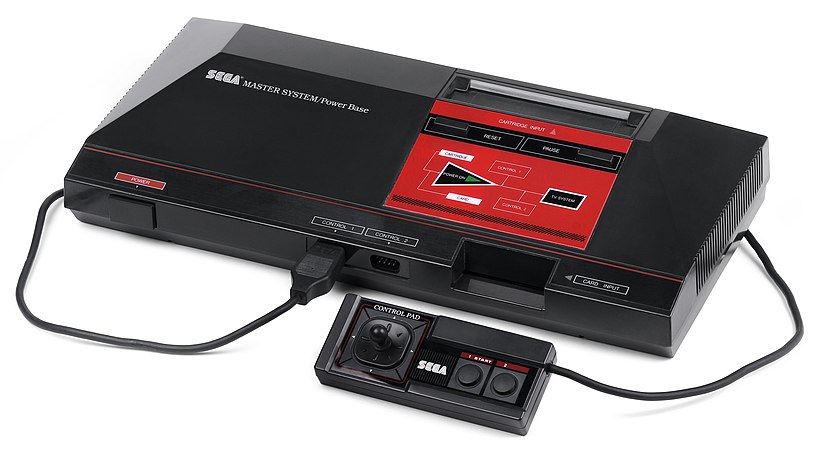History of video games/Platforms/Master System
-
The Sega Master System console and controller.
History
editLaunch
editThe Sega Master System was preceded by the SG-1000.
On October 20th, 1985, the Sega Master System launched in Japan.[1]
Legacy
editDiscontinued in Europe in 1996, the Master System sold over 20 million units.[2] The Master System saw it's greatest success in Brazil, where it enjoyed a status similar to the NES in North America and remained popular and in production even in the year 2016.[3] Elsewhere the Master System was a more modest success, where it sold 1 million units in Japan, 2 million units in North America, and 6.8 million units in Europe.[1]
The Sega Master System was followed by the Sega Mega Drive and Sega Genesis.
Technology
editCompute
editThe Sega Master System is powered by an 8-bit Zilog Z80 processor clocked at 3.58 megahertz, with an identical second source NEC D780C-1 CPU being used alternitively sometimes.[4][5]
The Master System has eight kilobytes of RAM and 16 kilobytes of low latency VRAM.[4]
The Master System uses a modified TMS9918 processor, called the Video Display Processor, with added features over the base design by adding mode 4.[4][6] The VDP also includes a Texas Instruments SN76489 for sound.[4][7][8]
Accessories
editSegaScope 3D Glasses
editThe glasses were released at a cost of ~$50 in North America, Europe, and Japan in 1987.[9]
Game case
editGames boxes for the Sega Master System games were made of durable plastic.[10] Box art for these games was relatively uniform.[11][12]
Notable games
edit1986
editAlex Kidd
editRead more about Alex Kidd in Miracle World on Wikipedia.
1987
editPhantasy Star
editPhantasy Star is noted as an early example of a game with a female protagonist.[13]
Read more about Phantasy Star on Wikipedia.
Gallery
editMaster System Console
editConsole Variants
editMotherboard
editMarketing
edit-
Sega Master System logotype.
-
Sega Mark III logotype.
External Resources
editReferences
edit| Parts of this page are based on materials from: Wikipedia: the free encyclopedia. |
- ↑ a b "Sega Consoles: What You Need to Know About the Retro Game Giant". CBR. 5 May 2019. https://www.cbr.com/sega-consoles-retro-game-history/. Retrieved 24 October 2020.
- ↑ "Sega Master System (1986 - 1996)". Museum of Obsolete Media. 26 February 2014. Retrieved 28 October 2020.
- ↑ "Brazil's Obsession With the Sega Genesis Won't Slow Down" (in en-us). Gizmodo. https://gizmodo.com/brazils-obsession-with-the-sega-genesis-wont-slow-down-1788698522. Retrieved 24 October 2020.
- ↑ a b c d "Sega Master System Architecture A Practical Analysis". Rodrigo's Stuff. 12 October 2020. Retrieved 7 November 2020.
- ↑ "Prototype Master System: M404 - Development - SMS Power!". www.smspower.org. Retrieved 7 November 2020.
- ↑ "TMS9918a - Development - SMS Power!". www.smspower.org. Retrieved 7 November 2020.
- ↑ Langston, J. B. (11 October 2020). "jblang/SN76489". Retrieved 7 November 2020.
- ↑ "SEGA MASTER SYSTEM TECHNICAL INFORMATION". Retrieved 7 November 2020.
- ↑ "That Time Nintendo and Sega Introduced 3D Gaming, In 1987". Kotaku. Retrieved 24 October 2020.
- ↑ "Collecting Sega Master System Games Is A Huge Pain In The Ass" (in en-us). Kotaku. https://kotaku.com/collecting-sega-master-system-games-is-a-huge-pain-in-t-1795243730. Retrieved 24 October 2020.
- ↑ "Happy 25th Birthday, Sega Master System!". Kotaku. Retrieved 24 October 2020.
- ↑ "The Laziest Box Art in Video Game History" (in en-us). Kotaku. https://kotaku.com/the-laziest-box-art-in-video-game-history-5886757. Retrieved 27 October 2020.
- ↑ "A Brief History of Women in Gaming: The 1980s - The Strong National Museum of Play". Google Arts & Culture. Retrieved 14 December 2020.
